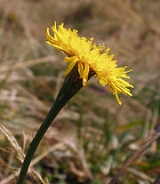
Leontodon pyrenaicus
Encyclopedia
Leontodon pyrenaicus is a species of hawkbit
found in the Alps
, Pyrenees
, Cantabrian Mountains
, northern Apennines
and northern parts of the Balkan Peninsula
. It grows in meadow
s and on stony slopes from the tree line to over 3000 m, usually on acid
ic soils. It is perennial
, and flowers from June to August.
The stems of L. pyrenaicus are narrow, up to 30 cm long, with several scale-like leaves, and with a single flower head
at the top. The leaves form a basal rosette
, and are clearly stalked. The flower heads are 20–20 mm wide and bright yellow.
L. pyrenaicus is divided into three allopatric subspecies
which differ in their size and in the nature of the hairs on the bract
s:
A number of authors since 2006, based on molecular evidence, have divided the genus Leontodon into two, with the former subgenus
Oporinia split out into the genus Scorzoneroides. If this is done, L. pyrenaicus is placed in Scorzoneroides as S. pyrenaica. It is also common for the subspecies to be considered separate species, in which case they are called Leontodon cantabricus (or Scorzoneroides cantabrica), L. helveticus (S. helvetica) and L. pyrenaicus (S. pyrenaica).
Hawkbit
Hawkbits are dandelion-like flowers in the family Asteraceae . Their English name derives from the mediæval belief that hawks ate the plant to improve their eyesight...
found in the Alps
Alps
The Alps is one of the great mountain range systems of Europe, stretching from Austria and Slovenia in the east through Italy, Switzerland, Liechtenstein and Germany to France in the west....
, Pyrenees
Pyrenees
The Pyrenees is a range of mountains in southwest Europe that forms a natural border between France and Spain...
, Cantabrian Mountains
Cantabrian Mountains
The Cantabrian Mountains or Cantabrian Range are one of the main systems of mountain ranges in Spain.They extend for more than approximately 180 miles across northern Spain, from the western limit of the Pyrenees to the edges of the Galician Massif close to Galicia, along the coast of the...
, northern Apennines
Apennine mountains
The Apennines or Apennine Mountains or Greek oros but just as often used alone as a noun. The ancient Greeks and Romans typically but not always used "mountain" in the singular to mean one or a range; thus, "the Apennine mountain" refers to the entire chain and is translated "the Apennine...
and northern parts of the Balkan Peninsula
Balkans
The Balkans is a geopolitical and cultural region of southeastern Europe...
. It grows in meadow
Meadow
A meadow is a field vegetated primarily by grass and other non-woody plants . The term is from Old English mædwe. In agriculture a meadow is grassland which is not grazed by domestic livestock but rather allowed to grow unchecked in order to make hay...
s and on stony slopes from the tree line to over 3000 m, usually on acid
Acid
An acid is a substance which reacts with a base. Commonly, acids can be identified as tasting sour, reacting with metals such as calcium, and bases like sodium carbonate. Aqueous acids have a pH of less than 7, where an acid of lower pH is typically stronger, and turn blue litmus paper red...
ic soils. It is perennial
Perennial plant
A perennial plant or simply perennial is a plant that lives for more than two years. The term is often used to differentiate a plant from shorter lived annuals and biennials. The term is sometimes misused by commercial gardeners or horticulturalists to describe only herbaceous perennials...
, and flowers from June to August.
The stems of L. pyrenaicus are narrow, up to 30 cm long, with several scale-like leaves, and with a single flower head
Inflorescence
An inflorescence is a group or cluster of flowers arranged on a stem that is composed of a main branch or a complicated arrangement of branches. Strictly, it is the part of the shoot of seed plants where flowers are formed and which is accordingly modified...
at the top. The leaves form a basal rosette
Rosette (botany)
In botany, a rosette is a circular arrangement of leaves, with all the leaves at a single height.Though rosettes usually sit near the soil, their structure is an example of a modified stem.-Function:...
, and are clearly stalked. The flower heads are 20–20 mm wide and bright yellow.
L. pyrenaicus is divided into three allopatric subspecies
Subspecies
Subspecies in biological classification, is either a taxonomic rank subordinate to species, ora taxonomic unit in that rank . A subspecies cannot be recognized in isolation: a species will either be recognized as having no subspecies at all or two or more, never just one...
which differ in their size and in the nature of the hairs on the bract
Bract
In botany, a bract is a modified or specialized leaf, especially one associated with a reproductive structure such as a flower, inflorescence axis, or cone scale. Bracts are often different from foliage leaves. They may be smaller, larger, or of a different color, shape, or texture...
s:
- L. pyrenaicus subsp. cantabricus lives in the Cantabrian Mountains
- L. pyrenaicus subsp. helveticus lives in the Alps, Apennines and Balkans
- L. pyrenaicus subsp. pyrenaicus lives in the Pyrenees
A number of authors since 2006, based on molecular evidence, have divided the genus Leontodon into two, with the former subgenus
Subgenus
In biology, a subgenus is a taxonomic rank directly below genus.In zoology, a subgeneric name can be used independently or included in a species name, in parentheses, placed between the generic name and the specific epithet: e.g. the Tiger Cowry of the Indo-Pacific, Cypraea tigris Linnaeus, which...
Oporinia split out into the genus Scorzoneroides. If this is done, L. pyrenaicus is placed in Scorzoneroides as S. pyrenaica. It is also common for the subspecies to be considered separate species, in which case they are called Leontodon cantabricus (or Scorzoneroides cantabrica), L. helveticus (S. helvetica) and L. pyrenaicus (S. pyrenaica).

